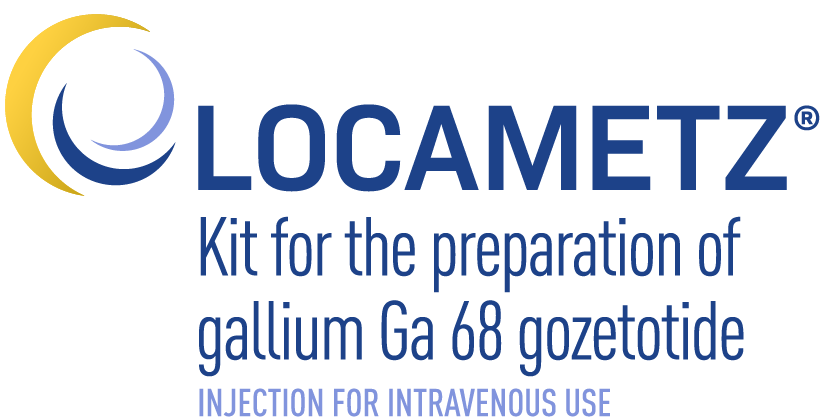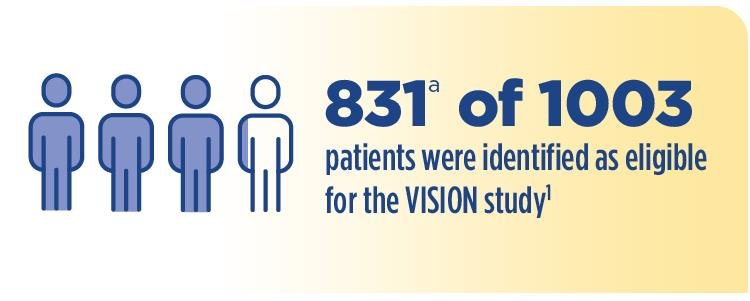Utility of PSMA PET/CT Imaging
Metastatic PC: Patient Selection for PSMA-Directed Therapy
PSMA PET/CT CONFIRMED PATIENT ELIGIBILITY FOR PSMA-DIRECTED THERAPY IN THE PHASE 3 VISION TRIAL1
Outcomes support gallium Ga 68 gozetotide PSMA PET/CT imaging as a method to select patients who may be eligible for PSMA-directed therapy1
VISION study design
The efficacy of LOCAMETZ for selecting patients for PSMA-directed therapy was established in the randomized, multicenter, open-label, phase 3 VISION study and the VISION reader substudy that evaluated imaging interpretation agreement
Using gallium Ga 68 gozetotide PSMA PET/CT imaging, 831* of 1003 patients were identified as eligible for the study and then randomized 2:1 to receive either lutetium Lu 177 vipivotide tetraxetan plus BSOC (n=551) or BSOC alone (n=280)
*The eligibility criteria for PSMA imaging were met in 869 patients. 831 were judged to have met all the trial eligibility criteria, including the PSMA imaging criteria, and were randomized 2:1 to each study arm.1,2
Based on their PSMA-positive status and other criteria
Consider a PSMA PET/CT scan to select patients with metastatic prostate cancer for whom lutetium Lu 177 vipivotide tetraxetan PSMA-directed therapy is indicated.
BSOC, best standard of care; CT, computed tomography; PC, prostate cancer; PET, positron emission tomography; PSMA, prostate-specific membrane antigen.
a The eligibility criteria for PSMA imaging were met in 869 patients. 831 were judged to have met all the trial eligibility criteria, including the PSMA imaging criteria, and were randomized 2:1 to each study arm.1,2
PC With Suspected Metastasis: Before Initial Definitive Therapy
THE RECEPTOR-BASED APPROACH OF PSMA PET IMAGING DEMONSTRATED STRONG PREDICTIVE VALUE WHEN COMPARED AGAINST HISTOPATHOLOGY1
The efficacy of LOCAMETZ in men with suspected metastasis who are candidates for initial definitive therapy has been established based on a study of another formulation of gallium Ga 68 gozetotide1
PSMA-PreRP was an open-label, prospective, 2-center study of 325 patients with biopsy-proven prostate cancer who were considered candidates for prostatectomy and pelvic lymph node dissection1
Each patient received a single gallium Ga 68 gozetotide PET/CT or PET/MRI from mid-thigh to skull base1
For each patient, gallium Ga 68 gozetotide PET results and reference standard histopathology obtained from dissected pelvic lymph nodes were compared by region (left hemipelvis, right hemipelvis, and other)1
Compared with reference standard histopathology, PSMA PET imaging demonstrated1:
61%Positive predictive value (95% CI, 41%-81%) | 84%Negative predictive value (95% CI, 79%-91%) |
MRI, magnetic resonance imaging; PSA, prostate-specfic antigen.
For patients with suspected metastasis who are candidates for initial definitive therapy, consider a PSMA PET/CT scan if you see1,a:
Serum PSA of at least 10 ng/mL
Tumor stage cT2b or greater
Gleason score >6
a Based on inclusion criteria for the PSMA-PreRP study. Institutional guidelines may vary.
PC: Suspected Biochemical Recurrence
>9 OF 10 EVALUABLE PATIENTS WITH EVIDENCE OF BIOCHEMICAL RECURRENCE WERE FOUND TO BE TRUE POSITIVE AFTER PSMA PET IMAGING1
The efficacy of LOCAMETZ in men with suspected recurrence based on elevated serum PSA level has been established based on studies of another formulation of gallium Ga 68 gozetotide1
PSMA-BCR was an open-label, 2-center prospective study of 635 patients who had biochemical evidence of recurrent prostate cancer after definitive therapy1,3
Biochemical recurrence was defined as PSA >0.2 ng/mL more than 6 weeks after prostatectomy or an increase in serum PSA of at least 2 ng/mL above nadir after definitive radiotherapy1,3
All patients received a single gallium Ga 68 gozetotide PSMA PET/CT or PSMA PET/MRI from mid-thigh to skull base; 210 had composite standard information collected in a PET-positive region (evaluable patients) consisting of at least 1 of the following: Histopathology, imaging (bone scintigraphy, CT, or MRI) acquired at baseline or within 12 months after gallium Ga 68 gozetotide PET, or serial serum PSA1,3
After 3 members of a pool of 9 independent central readers evaluated each PSMA PET/CT and PSMA PET/MRI scan1:
91% of evaluable patients were found to be true positive in 1 or more regions against the composite reference standard (95% CI, 88%-95%).a | |
Higher PSA = greater chance of detecting PSMA+ lesions The likelihood of identifying a gallium Ga 68 gozetotide PET-positive lesion in this study generally increased with higher serum PSA level. |
a Among the pool of 9 readers used in the study, the proportion of patients who were true positive in 1 or more regions ranged from 82% to 97%.
For patients with suspected recurrence, consider a PSMA PET/CT scan if you see1,a:
PSA >0.2 ng/mL more than 6 weeks after prostatectomy or
Increase in serum PSA of at least 2 ng/mL above nadir after definitive radiotherapy
a Based on inclusion criteria for the PSMA-BCR study. Institutional guidelines may vary.
Referring Patients for a PSMA PET/CT Scan
PSMA PET IMAGING* CAN HELP GUIDE MANAGEMENT OF PROSTATE CANCER ACROSS MULTIPLE SETTINGS1,3-6
Consider patients in your practice who could be candidates for a PSMA PET/CT scan and timing
To select patients with metastatic prostate cancer for whom lutetium Lu 177 vipivotide tetraxetan PSMA-directed therapy is indicated |
For patients with suspected metastasis who are candidates for initial definitive therapy1,a:
|
For patients with suspected biochemical recurrence1,b:
|
*PSMA PET imaging includes PSMA PET/CT and PSMA PET/MRI.
a Based on inclusion criteria for the PSMA-PreRP study. Institutional guidelines may vary.
b Based on inclusion criteria for the PSMA-BCR study. Institutional guidelines may vary.
REFERRING YOUR PATIENTS FOR A PSMA PET/CT SCAN STARTS WITH 1 SIMPLE STEP
Find the closest LOCAMETZ Scanning Center and contact information



